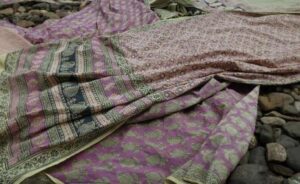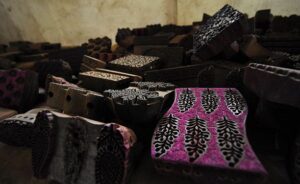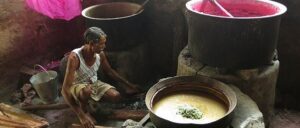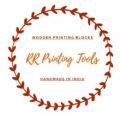Bagh Block Printing
Bagh Block Printing may be a traditional Indian handicraft originating in Bagh, Dhar district of Madhya Pradesh, India. The process is characterized by hand-carved wooden printing blocks used with naturally sourced pigments and dyes.
Bagh Block Printing fabric motifs are typically geometric, paisley, or floral compositions dyed with vegetable colors of red and black over a white background, and may be a popular textile printing product. Its name is derived from the village of Bagh located on the banks of the Bagh River.
History of Bagh Block Printing
The origins of the Bagh Block Printing designs are uncertain, but it’s believed that the practice is over 1,000 years old, with the techniques having been handed down through the family, from generation to generation.
The block-printed fabric was popular in the domestic market in Madhya Pradesh as Adivasi and Rajput communities used these printed fabrics for their dress and attire. Bagh’s unique craft of thappa chappai or block printing with natural colors has evolved from a rudimentary tribal art to a useful part of the heritage and cultural identity of Madhya Pradesh.
Some of the wooden printing blocks still used are two- to three hundred-years old. The traditional designs are inspired naturally, by the traditional Bagh Cave paintings, and therefore the jali (lattice) work of the Taj Mahal. Each block has a name:
- Chameli (jasmine)
- Neither (mushroom)
- Leheriya (waves)
- Keri (mango)
- Jurvaria (small dots)
In the 1960s, many craftsmen abandoned the normal process of Bagh Block Printing in favor of using synthetic fabrics. However, a number of artisans in the 1960s continued to practice and innovate within the traditional framework of the craft and brought Bagh prints to international prominence.
In 2011, a Bagh Block Printing on fabric was adopted during a tableau theme of the Madhya Pradesh state at the Republic Day parade in New Delhi on 26 January 2011. Featured within the parade was a Shalbhanjika, the celestial apsara of the 11th century, draped in Bagh-printed clothing.
More About Bagh Block Printing
Bagh Block printing is one of a type of “alizarin print”. It is practiced in the Bagh village of Madhya Pradesh. It got famous because of its geographical location. “Baghini river” has high copper content in its water, which gives a vibrant red color while dyeing with alizarin. And because of its local specialty it got geographical indicated brand status in the year 2009. Now a days for block color in Bagh printing, ready made iron rust called “Kashish” is employed in the process.
What is Alizarin Block Printing?
Alizarin printing is one of the foremost practiced techniques of hand block printing in India. It’s a sort of direct mordant based hand block printing technique. It’s called alizarin print because of the use of alizarin as a necessary element in the dyeing process. During this block printing technique basically two vegetable colors are used made of natural elements, are red or maroon and black. To print red color first alum mordant is printed then dyed with alizarin (Madder or al roots) to induce red color but today synthetic alizarin is employed in the process due to easy availability and value factor and black color extracted by fermenting jaggery powder with iron rust.
Other Important Alizarin Printing Process:
Bagru block printing is also a famous type of alizarin hand block printing technique practised in Bagru village of Rajasthan situated on Jaipur-Ajmer highway 30 kilometers outside of Jaipur. In Bagru alizarin gives a pretty maroon red shade.
Tarapur village of Madhya Pradesh may be a less known place where alizarin hand block printing is additionally practiced. They practise this art form and printing is done in its traditional way and use “Kath” from jiggery powder and iron rust instead of “kashish”, for dark black color. It’s a small village located near “Ghambhiri” river. Here red from alizarin gives beautiful Venetian red shade.
Bagh Block Printing Process
Bagh Block Printing previously referred to as Alizarin Printing, is manual and laborious, involving several processes of repeated washing, dyeing, and printing.
1. Pre-printing process:

Pre-printing process starts with the initial washing of the fabric for printing and is known as Khara Karna. Cotton is the commonly used fabric; however, other fabrics include the Maheshwari suit material, Kosa silk, bamboo chicks, chiffon, crepe, georgette tissue, and mulberry silk. The Khara Karna washing process consists of washing fabric in running water for at least two hours and beating the fabric on river stones to remove starch.
Next process is Mengni Karna. In this process fabric is soaked in a water solution mengni (goat dung), castor oil and rock salt. Then the fabric is pressed, rinsed, and dried, this process in continued three times. Then, the cloth is pre-dyed with Harara to provide an off-white base color, which also adds richness to the black and red dyes that will be applied later.
2. Printing:

Bagh Block Printing is done by hand, applying natural and vegetable-based dyes using carved wooden printing blocks. Red and black dyes are the commonest, but indigo, mustard, and khaki dyes are also used.
New Wooden Printing Blocks for printing are hand-carved from teak or Sheesham wood, but some blocks have been in use for 200 – 300 years. Motifs for the Bagh Block Printing are geometric or floral, sometimes inspired by the 1,500-year-old paintings at Bagh Caves.
Dyes for Bagh Block Printing are derived from plant sources (plants, fruits, and flowers), and minerals. To make the dyes, pigments like ferrous sulfate and alum are boiled in water and mixed with tamarind seed powder to make a paste, which acts as black and red dyes respectively. Other colors like indigo, mustard, and khaki are often made using indigo leaves, dhavdi leaves, or pomegranate rinds.
3. Wooden Printing blocks used in Bagh Block Printing:
The wooden printing blocks used in Bagh Block Printing are known as bilals, made of intricate and deeply carved teak or Sheesham wood and are frequently sourced from Pethapur, Gandhinagar, and Jaipur.
The wooden printing blocks can be reused and collected over generations, with some family libraries holding thousands of individual designs. Some blocks are aged up to 300 years old and are in use for so long that they’re known by particular names.
New blocks are often manufactured with new and latest motifs to keep up with market demands, but it is also made sure that the new design is a variation of traditionally accepted design. Common motifs include geometric shapes and also natural forms like jasmine, mushroom, mango, or small dots on a field.
4. Printing process
In order to use the right amount of dye to the printing block, a wooden reservoir, called a palea, is crammed with dye. A bamboo mesh (kartali) wrapped in wool is about to float within the reservoir, absorbing the dye and transferring the color when the printing block is rested on top.
The cloth to be printed is laid over a table known as Farsi. This Farsi or table is made of red sandstone, which is padded with extra cloth to serve as a base for printing. The printing is done by hands, by an expert printer producing five yards of cloth in two to three hours, depending on the complexity of the pattern.
Once the pattern is fully printed, the fabric rests for 8 to 14 days to permit the dye to completely absorb into the fabric.

5. Post-printing
Once the fabric has rested, it’s delivered to the river and rigorously washed for 20 minutes, and beaten against river stones to get rid of excess dye. This process is known as Bichalna. It requires both strength and attention, because any smudges or stains left after improper washing will be permanent.
The fabric is then fixed and finished within the Bhatti process, where it is boiled with a mixture of water, Alizarin, and Dhavda flowers. The fabric is constantly shifted and turned with long sticks as the temperature of the solution is slowly increased, which aids in the proper development of the colors.
The whole process takes from 4 to 6 hours. Finally, the bagh print fabric is washed three times again and the fabric is ready.
